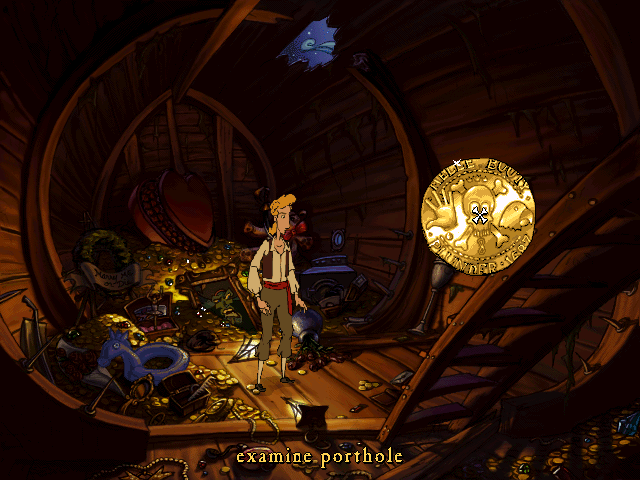Mike Russo analyzes limited-parser games and parser-like choice games, and compares their design and motivations to those of graphical point-n-click adventure games.
This article contains game-mechanical spoilers for Trouble in Sector 471, The Wizard Sniffer, A Murder in Fairyland, and the Bones of Rosalinda – specific plot elements and puzzle solutions aren’t discussed, but it does go into reasonable detail on the interfaces and kinds of puzzles each game offers.
The contemporary amateur IF scene is made up of two halves, both alike in dignity – parser-based games and choice-based ones, a division quite reified in the IF community. Even this magazine’s announcement post specified that would be a venue for discussion of “both parser-based and choice-based interactive fiction,” and entrants to IFComp, the community’s major annual competition, select either parser-based or choice-based labels for their games as an important way to communicate expected gameplay to potential players.1
This seemingly Manichean distinction, however, masks some areas of notable overlap. While each year’s Comp sees excellent examples of both traditional parser games that hearken back to the Infocom days, and choice-based games that could be just as easily be implemented as a paper book with numbered paragraphs, there are also an increasing number of odd ducks, enough to have given rise to their own subgenres.2 On the parser side, there are so-called “limited-parser” games, where the notionally open-ended possibilities for player input offered by a text parser are reduced to a much smaller list of identified options. On the choice-based side, there are “parser-like” choice games, which go beyond high-level narrative choices to include gameplay elements more common in parser games, like a persistent world model, compass-based navigation, a player inventory, or verb-noun interactions. 3 For all that these are new developments, they also hearken back to something old: the interfaces and design approaches being pursued in these subgenres bear an unmistakable resemblance to those used in graphic adventures, especially the classic late 1980s/early 1990s “point and click” form.
This essay presents this convergent perspective in some depth – first by analyzing limited-parser and parser-like choice games to understand how they work and identify points of similarity with graphic adventures, then discussing why this convergence is happening, and finally considering design implications that authors and players may wish to consider in creating and evaluating these games through the lens of their shared elements.
Constraints
Despite the infinite potential promised by their interface – “you can type anything, and the game will understand it!” – in a certain sense all parser games have a limited parser. They have a finite vocabulary, and it typically doesn’t take long for a player to run up against the boundaries of even a robust implementation. So the label “limited parser” doesn’t fully communicate what’s distinctive about this subgenre –and there probably isn’t a bright line to be drawn between limited-parser games and the mainline parser tradition.
This doesn’t mean we’re stuck with a Potter-Stewart style we-just-know-it-when-we-see-it definition, though – especially since in this essay I’m primarily interested in games at the core rather than the fuzzy periphery. For present purposes, these are the key elements:
- A relatively small list of possible commands. What does “relatively” mean in practice? Treasures of a Slaver’s Kingdom has five main verbs, which is clearly few enough to count; 77 Verbs, featuring all the actions built into Inform’s standard rules in turn, just as clearly has too many. To propose a rule of thumb, I’d say that if you’re getting much above ten actions, you’re probably not playing a limited-parser game.
- The list of possible commands is obvious to the player. At any moment in a limited-parser game, the player should know exactly what commands will be accepted – typically through a prominently-highlighted VERBS or COMMANDS option. This is where the distinction with mainline games is likely sharpest – for example, by contemporary standards the parsers in early Scott Adams games are quite limited, but the manuals typically played coy about exactly what commands the game would accept.
- Puzzles. This criterion distinguishes limited-parser games from puzzleless, narrative-heavy games that may require only a limited number of commands, often just moving, talking, and picking numbered dialogue options from a list. Despite some common features, the design approaches of these puzzleless games are distinct from those of limited-parser games, so for purposes of this essay I’m not going to be including them.
These are fairly modest constraints, and if one hasn’t played a limited-parser game, one could be forgiven for thinking that the differences from mainline parser games are only a matter of degree, not of kind. Yet the experience of playing them is often quite distinctive, as a few recent examples may illustrate:
Trouble in Sector 471
Arthur DiBianca is one of the leading lights of the limited-parser movement; in his latest game you play a plucky little maintenance-bot, out first to restore power to the eponymous sci-fi facility and then to zap the infestation of bugs at the root of the problem, while helping some of your fellow worker robots along the way.
The game clearly communicates that its parser is intentionally limited – right before the opening command prompt, the player is told “(This game has limited commands. Type HELP for a list.)” Once dutifully typed in, the HELP text reveals that besides some game-management actions, the standard movement commands, looking, and waiting, the robot’s only initial capacities are COM – talking to another robot – and ZAP – for electrocuting the bugs. Notably, this list does not include the ubiquitous EXAMINE command, meaning that the typical IF-player’s instinct of eyeing up every noun mentioned in a location’s description is fruitless.
Similarly absent from the initial command set is inventory management; while later on the PIK command is unlocked, this allows the robot to hold only a single item at a time, creating quite a contrast from the sprawling inventory of the prototypical IF protagonist. And besides PIK, there are only two other commands unlocked over the course of the game: ROX, allowing you to interface with switches and other machinery, and HUP, which lets your little robot hop into the air (Trouble in Sector 471 borrows its structure from the Metroidvania subgenre of platform games, with the player encountering various locked doors and other obstacles before acquiring the upgrades allowing them to be bypassed). That’s quite the parsimonious list – and yet despite this limited action palette, many of the puzzles are tricky, involving multiple steps and building on small details across a large map, so the game requires careful observation and attention to timing to solve. Precisely because the robot’s capabilities are so restricted, each upgrade feels like a significant increase to the game’s possibility-space – the always-available automap also reinforces this by continually showing the player which areas they’ve yet to explore:
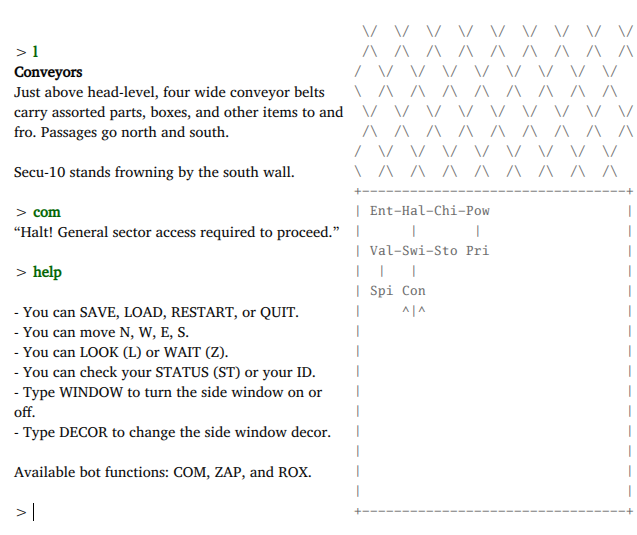
The Wizard Sniffer
The winner of 2017’s IFComp, The Wizard Sniffer is in many ways a traditional piece of parser IF: it’s a fantasy comedy where you rove around a big castle, solving puzzles on the way to rescuing a princess from a wizard. It boasts more than a few twists on the formula, however, chief among them being that you’re not playing the knight who’s undertaken this quest, but rather the pig with alleged magic-detecting powers that he’s brought along to help.
Much of the standard IF vocabulary is thus off-limits, with the built-in COMMANDS action (which is again prompted in the game’s opening text) offering the following parsimonious list:
> COMMA
[You may: EXAMINE, LOOK, TAKE, DROP, WAIT, SNIFF, DRINK, INVENTORY, or travel in any available direction.]SNIFF is the primary action, as the NPCs you are traveling with will take their own actions based on your displays of olfactory interest. The aforementioned knight, for example, will try to smash anything you sniff at, thinking that you’ve sussed out the hiding place of the shapeshifting wizard. His squire, thankfully, isn’t quite so sword-happy and is available when a more low-key approach is required. As a result, picking which NPC is following you when you SNIFF a particular object forms the basis of many of the puzzles. Combined with the large map, and a few puzzles that do require you to take actions yourself, this relatively bare-bones parser supports a big, engaging game that’s not especially difficult but is by no means trivial to solve.
Gameplay analysis
These two games are quite different, and a quick perusal of the 41 other games tagged with “limited verbs” on IFDB reveals a broad diversity of genres, game styles, and authors.4 Nonetheless, there are some common threads that we can pull out of this multifarious tapestry to assess limited-parser gameplay.
The clearest advantage is that the limited-parser game largely eliminates the frustration of playing guess-the-verb. In a mainline parser game, picking up on subtle prompts to intuit what commands will be accepted can be part of the fun, but it takes quite a lot of authorial skill to make this a smooth process. The player instead may feel like they’re beating against a brick wall, trying and failing to read the author’s mind and find the one set of synonyms that the game is looking for. Contrarily, in a limited-parser game, it’s almost always the case that if a player has an idea for something to try, translating that into the proper syntax will be straightforward. On the author’s end, it can also dramatically speed up development and debugging, as large swaths of a parser engine’s world model can be safely disregarded, and plausible alternative solutions need not be addressed if they’d require capabilities the limited parser doesn’t offer.5
The potential downside is that gameplay can become mechanical, as the player may resort to trying each possible action on each possible noun, which in turn can make engagement feel shallow: we’ve all played games where a vague indication that a man wants something from us leads to GIVE TELEGRAM TO MAN. GIVE NEWSPAPER TO MAN. GIVE BOOK TO MAN. GIVE STATUETTE TO MAN… until our eyes glaze over – this is the so-called “lawnmower” approach to a game, because you wind up ploddingly going over every possible piece of ground.
Mainline parser games can be subject to the same flaw, of course, but the uncertainty over which verb to type and whether it will be accepted can add an element of engagement and interest. Thus, well-designed limited-parser games often boast gameplay that prevents this degenerate strategy from being appealing by going beyond simple verb-the-noun puzzles. As discussed, Sector 471 uses Metroidvania elements in tandem with a large map, so the player is unlikely to have the right tool to solve a puzzle when it’s first encountered – so they must think back to all the nails they’ve seen whenever they find a new hammer. Wizard Sniffer, meanwhile, has its multiple NPC followers who interpret SNIFF differently, with the annoyance of swapping NPCs being just high enough to make it more fun to think through obstacles rather than resort to the lawnmower. Other limited-parser games make timing a key part of their gameplay, or involve sequencing multiple actions, to stymie the brute force approach.
The parserless parser-like
If “limited-parser” is a somewhat question-begging label – how limited is limited? – the label for our second subgenre of interest is even worse, because “parser-like” choice games rarely employ the actual parsing of text.6 Instead, they implement elements of a world model similar to the one built into most parser games, while their interfaces remain purely choice-based. Their primary features include:
- Navigation: while the classic Choose-Your-Own-Adventure style choice game can be visualized as a branching river, with the player’s choices switching streams as they’re carried ever forward, a parser-like choice game often allows the player to wander around a map and even return to places they’ve already been, moving through space rather than time. Some employ compass-based directions, aping the parser approach very closely, while others just describe movement options (e.g. open the door, walk to the store), but functionally there’s little difference.7
- Inventory system: carrying stuff around in order to use it is one of the basic elements of classic parser IF, and most parser-like choice games likewise afford this capability to their players. There are ways of letting the player accumulate stuff that don’t amount to an inventory system – many choice games simply set flags for when a player goes down a branch that sees them pick something up, and then automatically offer a choice to use that item at an appropriate time. Parser-like games may allow the player to see what they’re carrying at any time, drop items in different locations (if navigation is implemented), and use their items any time they like.
- Interactive objects: rather than simply having a list of narrative choices at the bottom of a passage of text, as is in the case in many choice games, parser-like ones may allow players to engage with objects by highlighting them when they come up in the text. Clicking these links can simply let the player examine the thing in more detail, or lead to sub-menus where the player can try a variety of different actions.
- Puzzles: this might again seem an odd criterion to include, because why would an author build out all these features only to ignore them? But it’s relevant because of gamebook-style choice IF, which substitutes RPG-style mechanics and combat for adventure-game tropes. This subgenre has a long history, going back to the Fighting Fantasy books of the 1980, but given its distinct design approaches and inspirations, it makes little sense to apply the label “parser-like” to games of this lineage.
Unlike my definition of limited-parser games, where all the criteria would need to be met for a game to qualify for the subgenre, it makes more sense to take a mix-and-match approach to defining the parser-like choice game; a game may only include one or two of these features, or it might implement a different set of world-model features from those identified above, but still fall within the subgenre.8 Let’s look at some examples:
A Murder in Fairyland
Abigail Corfman is an author who’s done a lot of work in this particular area, including two large commercial parser-like Twine games – Open Sorcery and its sequel, Open Sorcery: Sea++. A Murder in Fairyland is an excerpt from the latter, spinning a self-contained yarn about solving, well, it says it on the tin. This is a deviously puzzle-y affair, involving the predictable interrogation of suspects and gathering of clues, but also incorporating a series of minigames, from the quotidian (there’s a wordsearch) to the awesome – an entire system allowing you to manipulate the fairies’ bureaucracy by filling out a series of different forms.9 The interface is quite parser-like. Here’s a representative screen:
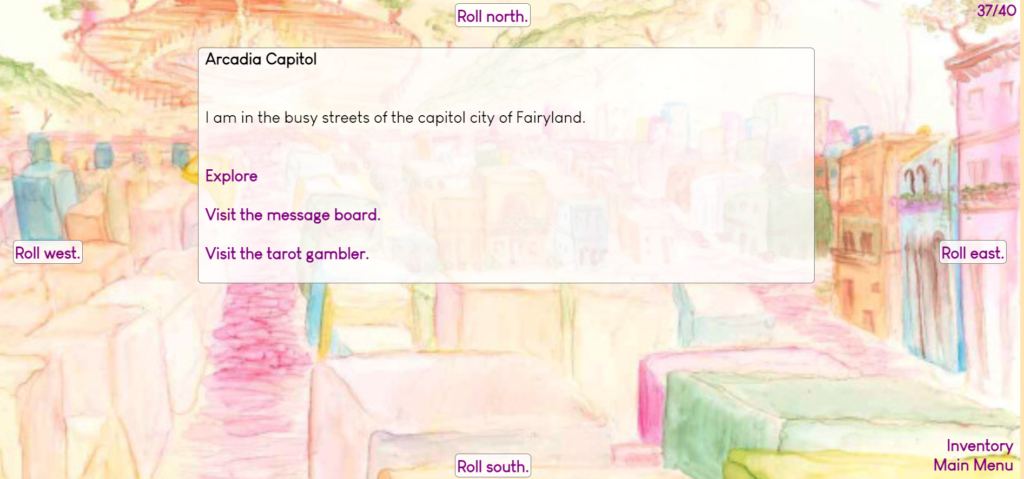
The edges allow for compass navigation (the player character uses a wheelchair, thus “roll”), while a robust inventory is tucked into the lower-right – this holds objects you’ve picked up, as well as listing the spells you know and the various flavors of magical juice currently empowering you. While there aren’t directly interactive objects, because most locations feature several characters or features to interact with and you need to click on the relevant link to begin engaging them, it’s not always clear whether you’ve unlocked a new option, making lawnmowering challenging; efficient progress requires deduction and careful attention to detail.
The Bones of Rosalinda
Agnieszka Trzaska is another leading light of the parser-like choice game movement, with a host of award-winning games in the subgenre. The Bones of Rosalinda, which took top honors in 2022’s Spring Thing, is an enjoyable example of the form. As a plucky, free-willed skeleton, the player works to defeat a villainous necromancer alongside a mouse sidekick, via an interface that gives the player plenty of options:
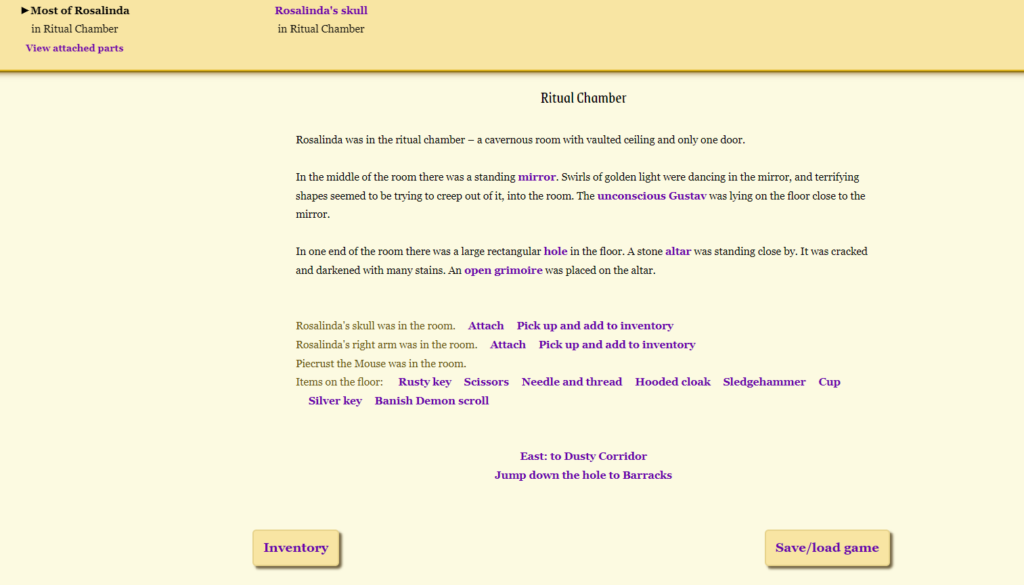
Again, we have compass directions and an inventory, and here, interactive nouns – clicking on any of the highlighted objects will pop up a new window that usually just contains a more detailed description, but occasionally will offer an additional submenu for further interactions. For inventory items, this includes a USE command, which allows you to click on any other noun, either in your inventory or in the location, so the player can indicate a target for the proposed action.
An additional aspect of the interface supports the game’s central gimmick – as an animate skeleton, Rosalinda can hive off various limbs of her body so that she can be active in several places at once. The body part list in the header menu allows the player to swap between which bones are taking actions, opening up some clever puzzle solutions.
Gameplay analysis
Having explored some examples in depth, we can now see some commonalities in how a parser-like choice-based game plays. The player explores a persistent space, often revisiting earlier locations as they gain new options, typically accreting in the form of new inventory objects or capabilities. When confronted with puzzles or barriers, the player surmounts them either via object manipulation, choreographing a particular pattern of actions, or triumphing in the occasional minigame.
So far so parser-like, but of course all of this is accomplished through a choice-based interface; while the player may occasionally be overwhelmed by possibilities, there’s rarely any doubt about how to make any particular idea understood to the game – indeed, many parser-like choice games employ a general USE command rather than requiring the player to specify precisely how they’d like one object to act on the other. If all else fails, simply clicking each possible action on each possible noun, or each inventory object on everything in sight, may serve to progress, though enjoyable games in this subgenre rely on a wealth of options, minigames, or unique systems like Rosalinda’s severable body parts to make this lawnmowering approach unappealing.
The above two paragraphs repeat most of what was said in the earlier gameplay analysis of limited-parser games. There are some differences, true – in particular, while implementing a limited-parser approach typically makes the job of a parser game author easier, building out parser-like features in a choice-based engine typically puts a greater burden on the author, because these kinds of systems are not included by default in the most popular authoring tools.10 But that’s of little moment to the player of such games, who will experience a distinct similarity in what it’s like to play games from these two subgenres. And players of a certain age might pick up on another whiff of similarity as well…
Forward to the past
We’ve established that limited-parser and parser-like choice games boast gameplay that bears more than a family resemblance to each other. In both, the player typically wanders a map, solving puzzles and accumulating items and information with which to solve more puzzles; in both, the primary modes of interaction involve picking one of a few listed actions at a particular location or with respect to a particular noun, or using one item on another object in the world, or solving a minigame challenge that uses bespoke mechanics. While this is all accomplished through typing for a limited-parser game and clicking for a parser-like choice game, these concordances of design and interface mean that the difference doesn’t loom very large: it’s an interesting thought experiment to consider how a particular limited-parser game could be implemented with a choice-based interface, or vice versa.
They don’t just resemble each other, however: these two subgenres also bear more than a passing similarity to that blockbuster category of yesteryear, the point-and-click graphic adventure. Here, for example, is the 1987 classic Maniac Mansion (note the evergreen “Disco Sucks” poster):
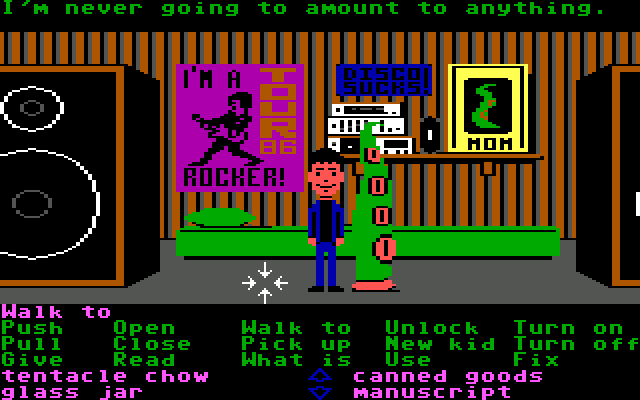
Navigation is accomplished by directly clicking on the appropriate exits, but other than that graphics-dependent flourish, the rest of this interface should by now look familiar. There’s an always-visible set of verbs, an inventory list immediately below it, and hotspots across the screen presenting various objects and characters (the “what is” action will display the name of an interactive object when the cursor is hovered over it). Commands are constructed by clicking the various parts of speech in order – perhaps first GIVE, then TENTACLE CHOW, then on the friendly green tentacle on the screen, adding up to GIVE TENTACLE CHOW TO GREEN TENTACLE. That’s all very parser-like, and the fifteen total actions on offer here are if anything a larger number than those found in some limited-parser games.
Maniac Mansion, as a relatively early game, sticks closer to the genre’s text-based roots, but the later evolution of the form shows this basic interface design never went away even as the number of words on screen went way, way down. Here’s Indiana Jones and the Fate of Atlantis, which adds icons for the inventory items and streamlines the number of actions down to just nine:
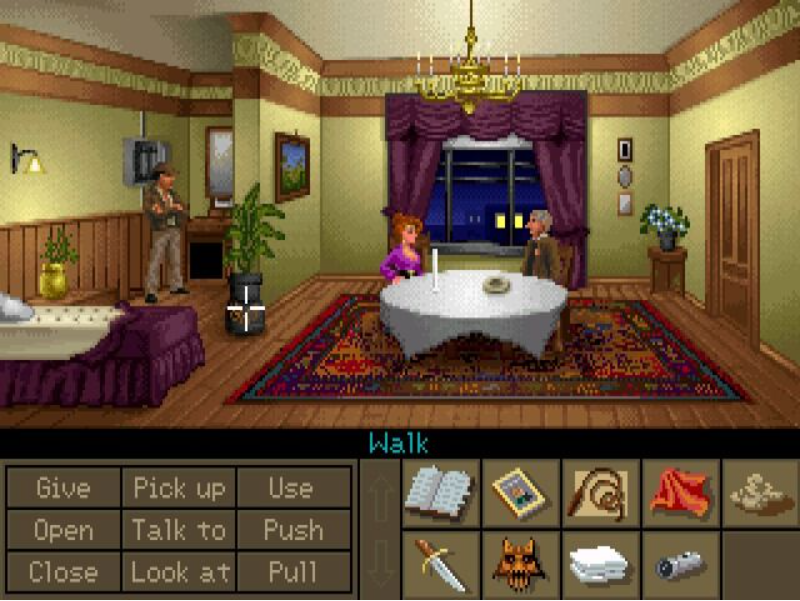
Five years later, Curse of Monkey Island would go even farther by representing the actions graphically, using a “verb coin” with only eyes (examine), hand (interact), and parrot head (attend Jimmy Buffet concert talk or eat):
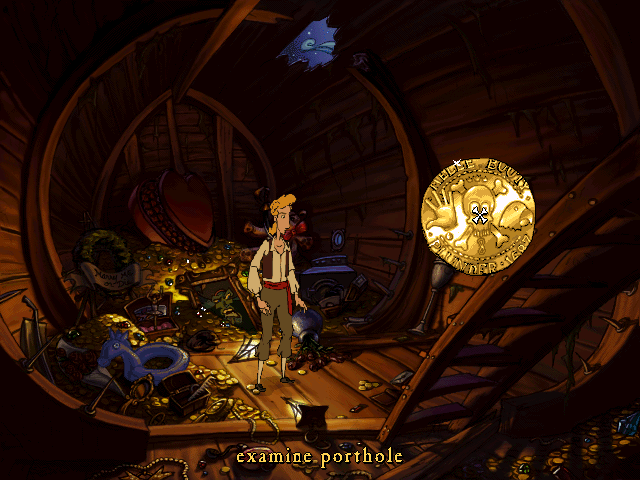
Again, the basics are the same: construct a command by selecting one of a limited palette of actions, then a target noun. This Monk3y screenshot boasts rich colors and Disney-quality graphics, sure, but that EXAMINE PORTHOLE at the bottom could come straight out of a piece of IF.
The analogy does break down if pushed too far; many later point-and-click interfaces eventually phased out alternate verbs entirely, for example, relying on a single general “use” action that doesn’t map well to most contemporary IF. On the flip side, there are limited-parser and parser-like choice games that don’t fit neatly into the point-and-click legacy, like Ascension of Limbs, which uses a limited-parser interface to present a shopkeeping simulation that doesn’t inherit much from adventure-game tradition. Still, admitting these caveats, the core insight remains: after decades of evolution, we see two subgenres coming out of distinct IF traditions converge on an approach strikingly similar to that employed by a sister branch of the adventure-game family tree.
This shouldn’t necessarily be surprising. The earliest point-and-click games were shaped by the then-dominant text-only adventure game, self-consciously adding visual bells and whistles – and a more accessible interface – to stand out from the games made by pioneers like Infocom.11 Similarly, both of our subgenres of interest need to be understood in the context of earlier IF traditions, with limited-parser games responding to the guess-the-verb unfriendliness of the mainline parser game and the parser-like choice game deepening the often non-existent world model of the mainline choice game. Responding to similar challenges, and influenced by common antecedents, authors across these three subgenres have converged on common approaches.
This hybrid moment
Parser games existed through the heyday of the graphic adventure; choice-based games haven’t been a central part of the IF community for quite as long, but authors have similarly had lots of time to try out different approaches. Yet – acknowledging that there are early examples like 2007’s Treasures of a Slaver’s Kingdom – the limited-parser and parser-like choice game have picked up most of their steam in recent years.12 Why?
One reason may be that the Twine wars are over, and we’re now reaping the peace dividend. The rise of choice-based games to peer status with parser games in the IF community was an often-contentious process, based on some good-faith concerns but also frequently driven by discomfort that a largely white, straight, male, cisgender, middle-class space was becoming more diverse and welcoming (it’s worth remembering that Depression Quest, the game initially at the center of GamerGate, was written in Twine).
Happily, the would-be gatekeepers decisively lost, and more than a decade on from the Twine revolution, the scene is much more unified. Based on the public conversations around IFComp, most judges appear to happily play games from both camps without obvious favoritism; reviewers write with an understanding of the distinct histories and design approaches of each tradition; there are even some authors who write both parser games and choice-based games as the spirit moves them.
It’s possible to be too Panglossian about this, of course – besides some lingering ill-feeling, there are still people who stick to playing only parser or only choice-based games, and with a few notable exceptions most authors exclusively create either parser or choice games. Nonetheless, the increased community norm of engaging with both parser and choice-based games has created cross-pollination between the two strands of IF, meaning there are authors primed to write hybrid works, and an audience primed to appreciate them.
A second reason is the simple passage of time. We are now thirtyish years on from the heyday of the point-and-click graphic adventure, so this is a ripe moment to look back on them fondly and try to recapture some of their recalled magic. 90s nostalgia has seized the culture at large in recent years, with Friends gaining a new audience via streaming and faux-vintage Nirvana t-shirts becoming a fashion statement;13 why would IF be any different? It also may be the case that 90s and aughts IF authors were less likely to import elements of point-and-click games into their work because of hard feelings: it was, after all, graphic adventures that killed Infocom and other purveyors of text-only games, a wound that may have felt fresh then but is scabbed over by now.14
Craft work
Noting the way limited-parser games and parser-like choice games have converged with the point-and-click game is interesting from the perspective of theory, but a viewpoint emphasizing these family resemblance can also point towards practical implications. Authors and critics can draw lessons, examples, and comparative frameworks from games that might have seemed to have little to do with each other. The section below sketches out a few open questions and points of departure for potential future analysis.
Interface design
One interface question that’s immediately presented by a look at graphic adventures is, well, graphic – should the interface be visible at all times? Point-and-click games gradually phased out the always-on-screen verb interface over time, presumably because increasing computer performance allowed them to animate larger areas of the screen and let players see more of the game’s art (increasing resolution and color depth also allowed it to stand up to better scrutiny). These considerations are largely absent from text games, of course, but the question still has significant gameplay implications. Both limited-parser games and parser-like choice games can either ensure the player can always see the actions presently available to them15 – or they can conceal them by default, requiring the player to click on a link or invoke a help command. The always-on approach might make puzzles friendlier, but could undermine a player’s engagement in a game’s narrative and descriptive prose by prompting them to consider text primarily in light of potential actions.
Another question hinging on the action list is whether the player should begin the game with the same set of possible verbs that they end with, as was standard with point-and-click games. Beyond the Sector 471 approach of giving the player more commands, and therefore more options, over time, there’s also the perversely empowering option of reducing the action palette over time. In His Majesty’s Royal Space Navy Service Handbook, for example, possible verbs are scratched off the HELP list as they’re successfully used to solve puzzles, meaning that later obstacles are easier to surmount than the earlier ones because the player has fewer permutations to consider.
Finally, there’s the issue of the overall size of the action list. Point-and-click games tended to pare down their verb palettes over time, until all the player could do was look at things or use them. Most current limited-parser and parser-like choice games have a broader range of potential actions, but is there something to be gained from further streamlining – or is this an impulse to be resisted? Relatedly, there’s the vexed question of the USE action: limited parser games often don’t have it, since they’re drawing from a parser tradition where USE is disfavored, while graphic adventures and parser-like choice games suffer from no such hesitation. In Sector 471, the ROX command more or less functions as USE, and you could make out a similar case for SNIFF in Wizard Sniffer, but it certainly feels different to type those words than to type USE.
Narrative design
One commonality between the two limited-parser games discussed above is that they feature nonhuman player characters, which serves as a diegetic explanation for their limitations relative to the broader verb sets of mainline parser-game protagonists. While there certainly are human PCs in limited-parser games, this impulse towards justifying the cut-down action list still recurs – part of the joke in Treasures of a Slaver’s Kingdom is that the barbarian hero only has so many ways of approaching a problem. Parser-like choice games, contrarily, don’t frequently build these kinds of limitations into their protagonists (likely because their PCs offer more granular agency compared to mainline choice games). Are these kinds of diegetic explanations broadly useful, supporting a deeper marriage between narrative and gameplay, or are they responding to concerns that most players never actually feel?
Puzzle design
As discussed in several places above, all three subgenres have grappled with the fundamental puzzle design challenge of lawnmowering – if you have a finite set of actions and a finite set of nouns, how do you keep gameplay from devolving into the unedifying process of combining each verb with each object until progress is made?
Graphic adventures sometimes turn to timing-based puzzles as a solution, but this is one place where limited-parser and parser-like choice games may be able to improve on their forebears. Many point-and-click games feature obstacles where the exact moment that a player issues a command is important, from invariably-annoying stealth sections to the infamous Broken Sword goat puzzle.16 These challenges are often awkward, because it’s hard to communicate how long an action will take in a real-time graphic environment, much less that time is suddenly important. In turn-based IF, however, these sorts of puzzles may be more natural, as durations are easier to signpost and the quantized nature of time makes it easier for players to plan.
Similarly, in a graphic adventure, movement is often the sole “analog” element, so puzzles can be constructed depending on the player’s exact location (at the risk of slight spoilers, that goat puzzle is also a movement puzzle). These share many of the same implementation challenges as time-based puzzles, as clicking on exactly the right place can be frustrating, but again, the discrete nature of movement in IF might make things like sneaking around a dynamically-moving enemy more rewarding to implement. I Am Prey, an entrant in this year’s Spring Thing IF festival, is a good proof-of-concept of this idea – its game mechanics center on a satisfying combination of traversal and evasion.
A third approach taken by point-and-click games is minigames. Beyond hackneyed stuff like requiring the player to win a logic puzzle to break into a computer, or ill-targeted choices like incorporating action-y bits into engines not designed for quick, responsive controls, the genre boasts beloved minigames like the insult swordfighting of Monkey Island, the RPG-inflected combat of Quest for Glory, or the high-stakes Voigt-Kampff test of Blade Runner. Authors might wish to explore similar options to add novelty to IF gameplay – for example, Skies Above, another Arthur DiBianca limited-parser game, is made up of nothing but minigames, though this may be going too far for some tastes.
Don’t fear the reaper
One final question before we wrap up – if it’s true that these two subgenres of IF are trending towards something resembling classic point-and-click graphic adventures, is it cause for concern that the reason I use the word “classic” is that the genre famously died some 25-odd years ago?17 Well, probably not. This “death” was overstated and parochial; the end of point-and-click games as a major proposition was largely an American phenomenon, with European sales of traditional adventure games remaining reasonably solid through the aughts. Much like IF, there’s also a longstanding indie point-and-click community, which has produced games whose commercial prospects may be modest compared to the revenues from a AAA game, but still dwarf anything the text-based game community has been able to produce in recent years – and that’s leaving aside the influence point-and-click games have had on other genres, including contemporary narrative games like Oxenfree or Life is Strange. Would that we’d suffered such a death!
Beyond that, most of the reasons adventure games declined in popularity had to do with the ballooning budgets to produce them – driven by the increasing costs of creating high-resolution art and, eventually, live-action video – and the linked software and hardware revolutions that allowed 3D action games to become rapidly more immersive, engaging, and responsive. These are hardly issues that concern contemporary IF authors!
Lest I end this section on too happy a note, though, it’s worth considering that there were other factors at play. Some developers certainly took their audience for granted, and assumed that players would go along with moon-logic puzzles and nonsensical stories, and the ongoing streamlining of interfaces into simpler and simpler forms sometimes led to less-engaging gameplay. There may be cautionary tales here for IF authors.
Conclusions
The discussion above is only one view of the cathedral: there are certainly other valid angles at which to consider these subgenres that would emphasize their differences rather than their similarities. If this isn’t the sole right lens through which to view these games, though, I believe that it’s a fruitful perspective. By placing limited-parser games, parser-like choice games, and point-and-click graphic adventures in a common context, the community can gain theoretical and practical insights.
There’s another, more aspirational reason why I think this particular corner of the IF landscape merits study, and particularly analysis that draws attention to the common features of these subgenres, which is that in my view these works of IF are pointing towards something fresh and exciting. Focusing on the way they hearken back to decades-old antecedents may risk making them seem retrograde. But there’s no need for us to subscribe to a Whig interpretation of IF history where the past is only ever prologue to the eternally-progressing present: acknowledging that there are debts owed to predecessors doesn’t preclude works in these subgenres from innovating.
While I would neither want nor expect the limited-parser game and parser-like choice game to make their respective mainline games obsolete, shifting the two poles of the IF sphere into closer alignment would, it seems to me, lead to better games and a stronger community. To the extent that a common legacy is allowing these two subgenres to dissolve boundaries and create contexts where IF’s accepted divide between parser and choice games doesn’t look so stark, it is helping shape the cutting edge. And working to expand the sphere where authors, critics, and players can come together for productive conversations regardless of their starting points is worthwhile indeed.
Footnotes
1 As a previous IFComp entrant, I recall that there has been a “hybrid” option presented to authors as well; however, no one appears to have exercised said option for at least the past two years, though some do simply refrain from making any choice at all.
2 See footnote 12 for an attempt at backing up this claim.
3 At some point in this sentence, dear reader, you may have leaned forward with a “wait just a minute” on your lips – we’re calling these games “parser-like” even though the stuff they’ve bolted onto the choice-based chassis has nothing to do with the actual text-parsing bits of parser games? Look, I’m not any happier about this than you are.
4 Entertainingly, now that I check this list, I see that someone included 77 Verbs, which I just confidently dismissed as obviously not a limited-parser game. Gotta love democracy!
5 For this point – and several others through this article – I’m indebted to Sam Kabo Ashwell’s exegesis of limited-parser games, Narrow Parsers. This argument is not universally true, though; there are some limited-parser games where the effort of manually redirecting unimplemented actions with custom responses can seem quite exhausting, with Eat Me being a notable example.
6 Some choice games do require the player to occasionally type in some text, typically in pop-up boxes. This can run the gamut from simply naming the player character, to minimally-reactive Mad Libs approaches, to a full-on parser-choice hybrid engine. None of these are really germane to a discussion of parser-like choice games, though – again, I agree, this isn’t a great name!
7 Unless you’re someone who has a hard time visualizing compass directions, in which case the latter approach is much superior.
8 Again, except for the last criterion, because gamebook-style works are doing their own thing.
9 Let me emphasize this comment is not sarcastic in the slightest; I loved these fill-out-a-form puzzles and dearly hope to see more technocratic puzzle systems in the future.
10 There are exceptions, of course – notably Gruescript, which is built specifically to support parser-like choice games.
11 Notably, the earliest generation of graphic adventures still required the player to type in what they were doing in order for the game to understand their actions, making the influence of text-only games direct indeed.
12 While a full historical analysis is beyond the scope of this article, in case you’d like something more quantitative to go with my hand-waving, of the 43 games with that “limited verb” IFDB tag, all but six are from the last ten years; as for the just-as-awkward “CYOA with location-based world model” tag, there are likewise only six tagged games published in 2013 or earlier.
13 I saw a two-year old sporting one when I went to pick up my son from day care last week, in fact, which feels like a sure sign the trend is on its way out.
14 Josh Grams suggested a third theory when reviewing a draft of this article: JavaScript, which underlies many of the main choice-based authoring tools, has become a more stable, powerful, and better-documented language over the past decade, meaning that the technical barriers to implementing more programmatically complex choice-based games have recently decreased.
15 It can get unwieldy if the list of options is long, but the use of subwindows can prevent this kind of feature from distracting from the corpus of a game’s text.
16 This last even has its own Wikipedia page (if you don’t recognize the game’s title, you might be an American, because it was marketed as Circle of Blood on our presumably more gore-hungry shores).
17 Conventionally, the exact time of death is dated either to 1999, when Gabriel Knight 3 came out, or 2000, when future Portal writers Erik Wolpaw and Chet Faliszek eviscerated that game’s cat-hair mustache puzzle.
References
- 77 Verbs, Brian Rushton. 2020.
- Ascension of Limbs, AKheon. 2020.
- The Bones of Rosalinda, Agnieszka Trzaska. 2022.
- His Majesty’s Royal Space Navy Service Handbook, Austin Auclair. 2023.
- I Am Prey, Joey Cramsey. 2023.
- A Murder in Fairyland, Abigail Corfman. 2020.
- The Wizard Sniffer, Buster Hudson. 2017.
- Skies Above, Arthur DiBianca. 2019.
- Treasures of a Slaver’s Kingdom, S. John Ross. 2007.
- Trouble in Sector 471, Arthur DiBianca. 2022.
Acknowledgments
This article benefitted from insightful feedback and suggestions from other members of the Rosbush editorial staff, as well as from Drew Cook; for any remaining errors and infelicities, as well as retaining the “Monk3y” joke despite knowing better, the author is entirely to blame.


